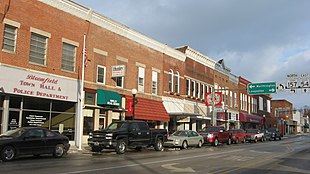Bloomfield, Indiana
| Bloomfield, Indiana | |
|---|---|
| Town | |

Buildings in downtown Bloomfield
|
|
 Location in the state of Indiana |
|
| Coordinates: 39°1′29″N 86°56′25″W / 39.02472°N 86.94028°WCoordinates: 39°1′29″N 86°56′25″W / 39.02472°N 86.94028°W | |
| Country | United States |
| State | Indiana |
| County | Greene |
| Township | Richland |
| Area | |
| • Total | 1.38 sq mi (3.57 km2) |
| • Land | 1.38 sq mi (3.57 km2) |
| • Water | 0 sq mi (0 km2) |
| Elevation | 607 ft (185 m) |
| Population (2010) | |
| • Total | 2,405 |
| • Estimate (2012) | 2,388 |
| • Density | 1,742.8/sq mi (672.9/km2) |
| Time zone | EST (UTC-5) |
| • Summer (DST) | EST (UTC-4) |
| ZIP code | 47424 |
| Area code | 812 |
| FIPS code | 18-05716 |
| GNIS ID | 431200 |
Bloomfield is a town in Richland Township, Greene County, Indiana, United States. The population was 2,405 at the 2010 census. The city is the county seat of Greene County.
Bloomfield is part of the Bloomington, Indiana Metropolitan Statistical Area.
The area where Bloomfield is located has been inhabited by Native Americans since prehistory. Tribes that have lived in the area include the Miami tribe, Kickapoo, Piankeshaw and Wea. A settlement of Woodland period people has been excavated by Indiana University and Ball State University research teams near the confluence of Richland Creek and the White River south of Bloomfield.
The town of Bloomfield was laid out in 1824 when Greene County needed a new county seat due to the lack of a reliable water source for the town of Burlington. Burlington was located west of Bloomfield near the west fork of the White River.
The town's first structure was the Greene County Courthouse, a log structure, in the center of town. The current Greene County Courthouse, a brick structure built in the late 19th century, stands at the same location. An expansion and renovation project was completed in 2008. It was listed on the National Register of Historic Places in 2008.
In 1824, Peter Cornelius Van Slyke donated land to Greene County for the purpose of establishing a new county seat. Van Slyke was born on the Mohawk River in Schenectady County, New York, on April 5, 1766. He migrated to southern Indiana in 1816. Van Slyke was a veteran of the War of 1812 and died on September 25, 1834.
...
Wikipedia
